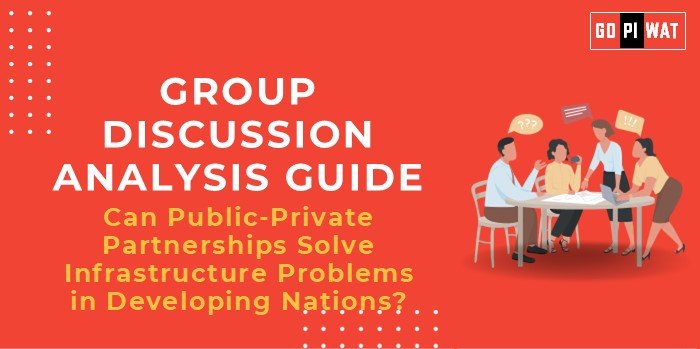📋 Group Discussion (GD) Analysis Guide
🌍 Topic: Can Public-Private Partnerships Solve Infrastructure Problems in Developing Nations?
📖 Introduction to the Topic
Opening Context: Developing nations face a $15 trillion infrastructure financing gap by 2040, according to the Global Infrastructure Outlook. Public-private partnerships (PPPs) have emerged as a potential solution to address this deficit while leveraging private sector efficiency.
Topic Background: PPPs combine public and private sector resources to fund, develop, and manage infrastructure projects, offering benefits like risk-sharing and innovation. However, their success depends on proper frameworks, transparency, and governance.
📊 Quick Facts and Key Statistics
- Global Infrastructure Deficit: Developing nations require $2.7 trillion annually to meet infrastructure needs (World Bank, 2023).
- PPP Investment Growth: In 2022, PPPs accounted for 20% of infrastructure projects in emerging markets (World Bank, 2023).
- Successful PPPs: Chile’s PPP model resulted in over $20 billion investments in road infrastructure since the 1990s.
- Challenges: 30% of PPP projects fail due to misaligned incentives and regulatory issues (IMF, 2022).
🤝 Stakeholders and Their Roles
- Governments: Provide land, approvals, and regulations while safeguarding public interest.
- Private Sector: Contribute capital, technology, and expertise to ensure project efficiency.
- International Organizations: Facilitate funding, frameworks, and technical assistance (e.g., World Bank, ADB).
- Local Communities: Ensure projects address societal needs without adverse impacts.
🏆 Achievements and Challenges
Achievements
- Efficiency Gains: Private sector management often results in timely project delivery and reduced costs.
- Access to Capital: PPPs attract private investment in regions where public funds are insufficient.
- Successful Models: Examples like Chile’s toll road PPPs and India’s highways demonstrate potential.
- Innovative Solutions: Integration of green technologies in projects, such as renewable energy PPPs in Africa.
Challenges
- Regulatory Hurdles: Complex and inconsistent regulations deter private investment.
- Risk Allocation Issues: Governments often bear more risk than private partners.
- Corruption and Transparency: Lack of clear frameworks can lead to inefficiencies and public mistrust.
🌍 Global Comparisons
- Chile: Pioneered successful road and airport PPPs, reducing travel time by 20%.
- India: The Delhi Metro PPP is a global benchmark, showcasing timely completion and operational efficiency.
- South Africa: Renewable energy PPPs have brought solar power to rural regions.
📚 Case Study
Kenya’s Nairobi Expressway: A PPP project that reduced travel times by 50%, showcasing the potential of private sector involvement in urban infrastructure.
🗣️ Structured Arguments for Discussion
- Supporting Stance: “PPPs enable efficient, innovative, and scalable infrastructure development in resource-constrained economies.”
- Opposing Stance: “Mismanagement and regulatory barriers make PPPs a risky solution for developing nations’ infrastructure needs.”
- Balanced Perspective: “While PPPs can address infrastructure gaps, their success depends on robust frameworks and equitable risk-sharing.”
📈 SWOT Analysis
- Strengths: Access to private capital, technological innovation, risk-sharing.
- Weaknesses: Regulatory complexity, potential public backlash, execution delays.
- Opportunities: Green infrastructure, international partnerships, digital advancements.
- Threats: Corruption, political instability, over-reliance on private entities.
🎓 Connecting with B-School Applications
- Real-World Applications: Explore themes in project finance, risk management, and public policy.
- Sample Interview Questions:
- “What factors determine the success of a PPP in infrastructure development?”
- “How can governments balance public interest with private profits in PPP projects?”
- Insights for Students: Study frameworks like BOT (Build-Operate-Transfer) and hybrid models to understand PPP dynamics.


